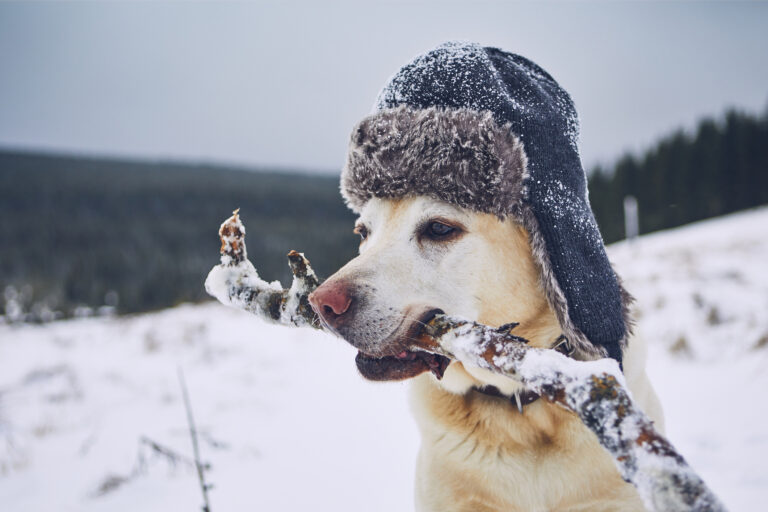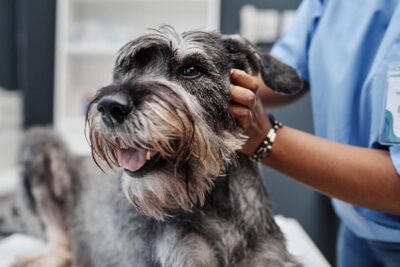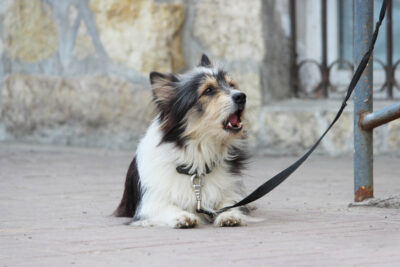Snow Nose Dog: Why Is My Dog’s Nose Turning Pink?

Has your dog’s nose suddenly gotten lighter in color? If this shift from dark to pale or even pink coincides with colder weather, you could have a snow nose dog on your hands.
“Snow nose” (also called dog winter nose) is a relatively rare condition in dogs. It happens when a dog’s natural nose pigment changes in response to cold weather. Though it may make your dog look a little odd, it’s considered harmless by veterinarians.
But not every light-colored nose is caused by snow nose. Here’s what you need to know about dog snow nose, including how to tell if your dog has it, or if it’s something more serious.
What is a Snow Nose Dog?
According to veterinary dermatologist Dr. Heather Edginton, DVM, ACVD, from Cornell University’s College of Veterinary Medicine, snow nose in dogs is not very common. As a result, there’s not a lot of research around the condition, which is officially called “nasal hypopigmentation.”
Here’s what we do know about snow nose in dogs. “What happens is the nose—just the nasal plane, the black part—lightens, but it doesn’t completely depigment,” Dr. Edginton says. “It typically happens in winter. Then, in spring or summer, it will get darker again.”
While uncommon, some breeds are more prone to developing snow nose. These include Siberian Huskies, Labrador Retrievers, Golden Retrievers, and Bernese Mountain Dogs.
Is snow nose bad for a dog? Dr. Edginton says that it isn’t. However, she warns that there are other reasons dogs might lose pigmentation on their nose, including concerning health conditions.
Does my dog have snow nose?
If you notice your dog’s nose changing color and aren’t sure whether it’s snow nose, here’s how to tell. The key is to observe if and how the color shifts over time.
For example, if your pup’s nose lightens during cold months and gradually returns to normal as temps rise, it’s probably snow nose.
By contrast, dogs born with naturally pink noses will maintain that lighter pigmentation throughout their lives. And if the color change is linked to an underlying health issue, a dog’s nose typically doesn’t return to its normal shade.
If you’re unsure, worried, or in doubt about why your dog’s nose is pink, always consult your veterinarian. They can diagnose whether you’re dealing with a case of snow nose or something else and provide the right treatment, if needed.
What Causes Snow Nose in Dogs?

“When you have an area of the skin that loses pigment, there’s usually a reason the melanin is decreasing,” Dr. Edginton says.
Winter nose on dogs appears to be linked to seasonal changes, since the nose lightens during colder months and returns to normal in summer. However, Dr. Edginton says that experts don’t fully understand the mechanism or underlying reason for this condition. More research is needed to understand the true cause.
Snow nose biopsies could provide insights about what’s happening within the skin cells, says Dr. Edginton. “But it’s hard to convince owners when it’s something that we’re telling them is benign,” she adds. “No one wants to put a hole in their dog’s nose to figure out why the benign thing is happening.”
Why Do Dog Noses Turn Pink? Other Causes to Consider
Beyond snow nose, there are many other potential reasons why a dog’s nose turns pink.
“If it’s de-pigmentating—losing pigment and then not coming back—that can actually be due to a lot of things,” says Dr. Edginton.
One possible cause for a pink nose is discoid lupus. This autoimmune disease causes a dog’s immune system to attack its own cells and tissues. One of the earliest signs of this condition is a change in nose pigmentation, typically from dark to pink. You may also notice loss of the nose’s cobblestone texture, as well as crusts, scabs, or ulcers.
Another potential cause for a dog’s nose turning pink is pemphigus, an autoimmune skin disease. In this case, Dr. Edginton says that dogs may develop crusting on the nose in addition to pigment loss.
UV dermatologic syndrome is another autoimmune condition that can lead to nose depigmentation. This relatively rare disease can also cause inflammation in the eyes, which may lead to blindness.
Additionally, prolonged sun exposure may lead to UV damage and, ultimately, a pink nose.
Certain forms of cancer—such as lymphoma—can also result in a dog’s nose appearing pink. This is one of the more serious causes to look out for, according to Dr. Edginton.
There are also benign causes to consider.
Lentigo, a harmless and asymptomatic skin condition, can cause pigmentation changes in dogs, including on a dog’s nose. Vitiligo, another non-threatening autoimmune condition, may also cause the appearance of a dog’s nose to change.
To determine the underlying cause of your dog’s pigmentation changes on their nose, Dr. Edginton says a veterinarian would likely perform a biopsy.
Dog Snow Nose Treatment and Prevention

Does snow nose need to be treated? “If it’s snow nose, then no,” says Dr. Edginton. That said, if in doubt, she urges pet parents to visit the veterinarian.
“I would say that if you’re starting to notice your dog’s nose decreasing in pigment, have your vet check them out,” she says. “In the best-case scenario, they say, ‘This looks like a benign process.’”
“But if it’s not,” she adds, “then that would be something to look into, especially if it is the beginning of cancer. Obviously, we always want to get to cancer before it starts to get worse.”
Final Thoughts on Snow Nose Dogs
If you’ve noticed your puppy’s nose turning pink or your dog’s nose is pink during colder months, it may simply be snow nose—a harmless, seasonal change.
Still, because other health issues can cause similar pigment loss, it’s always best to check with your vet to rule out anything serious. Most of the time, snow nose in dogs is nothing to worry about and doesn’t require treatment.
Hopefully, your vet can provide the all-clear. Then, you can enjoy the peace of mind that comes with knowing your dog’s snow nose is temporary and harmless to their health.









